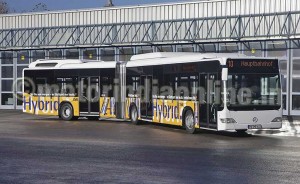By Hartmut Schick, Head of Daimler Buses
Today, I would like to show you the bus from an angle that you might not necessarily have seen before. This is an angle that fits in excellently with the motto of this year’s IAA – “Driving the Future” – and shows the bus in a particularly important role in future passenger transport.
In the title of my presentation I describe the bus as an attractive companion. That is why I would also like to begin by considering together with you: When is someone considered to be attractive?
Under attractiveness we understand an attribute that evokes a kind of “spontaneous liking” or “positive attitude”. The influencing factors are probably determined by the individual’s perception. But, if I may venture to make a generalisation, then it is certainly true that we find people attractive, who act with consideration, who have a pleasant appearance and manners and who create a sense of well-being in others. This fully applies to the bus.
The proof of this is simultaneously the agenda for my presentation:
• Buses give consideration to the environment as well as to people when it comes to the topic of safety, in particular when compared with the other modes of transportation.
• The positive appearance is characterized by innovative bus design.
• The well-being of the passengers is ensured by the extraordinarily high level of comfort and air-conditioning in state-of-the-art buses.
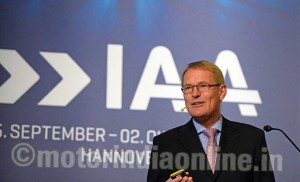
Let me now touch upon the ecological aspect. The future of mobility is environmentally friendly. If it is about transporting people in an environmentally friendly manner in the future, the bus will play a key role. Compared to other modes of transport, the coach generates the lowest CO2 emissions, as demonstrated by the data of the German Federal Environmental Authority.
In the framework of the Euro VI Emission Standard, which came into force this year, the emissions performance of the bus was dramatically improved. With a new engine generation and the costly exhaust purification, the emissions are at the validation limit.
The disadvantages in fuel consumption that were initially expected with Euro CI have been completely turned around through new developments in the vehicle and powertrain, for instance. A consumption test in the fall of 2012 shows this: The consumption advantages of Euro VI vs. Euro V are up to 8.5 per cent in the area of coaches as well as urban buses.
In the long term, manufacturers will have to improve this good performance even further. One step towards this direction is our strategy for alternative powertrains. At this time such products are not in demand in the market, simply because of the economic viability factor. However, I am absolutely certain that sooner or later this will change, and when the time comes, we will not come out with prototype solutions.
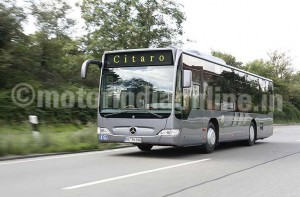 We are working intensively on an economically justifiable, mature and highly modular concept. I am convinced that in the long term the future belongs to the fuel cell. Through the groupwide development of the respective technologies we will be able to present an economical solution.
We are working intensively on an economically justifiable, mature and highly modular concept. I am convinced that in the long term the future belongs to the fuel cell. Through the groupwide development of the respective technologies we will be able to present an economical solution.
Accordingly, all our vehicle divisions are closely networked with respect to the key technologies, and we at the bus division will benefit from the integration with the truck and car divisions.
We can all benefit from yet another advantage of the bus, which makes it very attractive: its safety. Here, too, the bus is again taking on a leading role, which is also confirmed by the Federal Statistical Office in Germany: the bus has the lowest frequency of traffic accidents involving personal injuries.
Of course, the well-trained bus drivers are of primary importance for this. However, safety technologies are also making a key contribution: Just think of the great number of assistance systems in a modern bus – from attention assistants to the automated tire pressure controls and all the way to the brake assistant, which also activates the full power of the brakes for standing obstacles and thus actively prevents accidents.
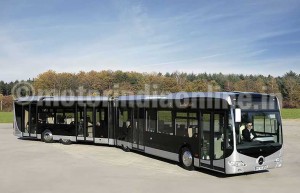 The bus supplements these advantages with yet another attractive aspect: a pleasant appearance. The jury of the prestigious red-dot design award began to take notice of buses a few years ago.
The bus supplements these advantages with yet another attractive aspect: a pleasant appearance. The jury of the prestigious red-dot design award began to take notice of buses a few years ago.
I am happy that our latest coach generation has also been honored with this award – even twice in two consecutive years. And, when it comes to design, in some areas people are already getting their money’s worth at the start of their bus trip.
So much for outward appearances. The inner values are also important, which brings me to the next point: the well-being or wellness factor. The comfort is awesome. Our interiors are reminiscent of first class in an airplane – but better since you can enjoy a panoramic roof that we have further enlarged by half. This is already being felt today. And will be felt even more in the future.
The trend researcher Matthias Horx even envisages a real busmania. In doing so, he cites such aspects as just these advances in comfort. Instead of “necessity”, “force” and “being transported”, travelling by bus is linked to keywords like “reliable”, “comfort” and “communal” – more closely than any other means of transport.
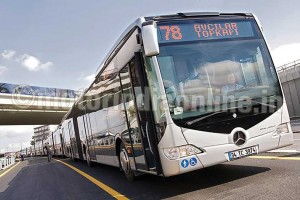 Bus and lifestyle are coming together to form the mobility lifestyle. The mobility lifestyle is characterized by the fact that those mobility offerings are used flexibly which appear to be the most advantageous in the specific case of need and are in line with the personal preferences of the individual.
Bus and lifestyle are coming together to form the mobility lifestyle. The mobility lifestyle is characterized by the fact that those mobility offerings are used flexibly which appear to be the most advantageous in the specific case of need and are in line with the personal preferences of the individual.
That the bus will increasingly be the preferred choice in the future is illustrated by two examples of comfortable and attractive mobility solutions in long- and short-distance transport.
In tourist travel these are the long-distance coaches, to take a recent example from Germany. Since the liberalization of long-distance transport they are attractive primarily for those tourists who want to be price-conscious about mobility, because buses are the most inexpensive mode of transport in German long-distance transport (Source: Comparison of Transportation Modes 2014, Fernbusse.de). According to one study, around 46 per cent of all users of long-distance bus transport would recommend it to others (Source: puls Marktforschung GmbH). This speaks in favor of further growth.
According to the Federal Ministry of Transport, the number of permits for long-distance bus lines in Germany nearly tripled between 2012 and 2013. This is where coaches show their full potential, which fully addresses the potential of buses in local public transport.
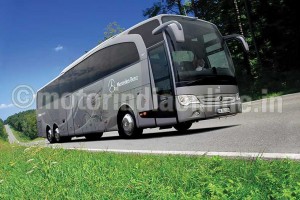 Here, I can name the Bus Rapid Transit concept which provides for separate bus lanes where special vehicles can drive with a higher frequency. Passengers appreciate the rapid transit, in particular on congested urban routes. In addition, our direct customers like the impressively rapid and inexpensive realization. Here, the bus systems score over other public modes of transport, as the numbers impressively show.
Here, I can name the Bus Rapid Transit concept which provides for separate bus lanes where special vehicles can drive with a higher frequency. Passengers appreciate the rapid transit, in particular on congested urban routes. In addition, our direct customers like the impressively rapid and inexpensive realization. Here, the bus systems score over other public modes of transport, as the numbers impressively show.
Let me highlight only one example, which is presented in the chart in the upper right: The same capital expenditure is sufficient to build 426 km of BRT systems in Bangkok or, alternatively, only a 7-km-long metro track. This makes BRT the ideal solution for public transport in rapidly growing cities whose number continues to rise due to the growing population and increasing urbanization.
So you see, I haven’t promised too much. The bus is definitively an attractive companion: environmentally friendly, safe, comfortable and an important player when it comes to mobility solutions of the future. Has the bus now awakened a “spontaneous liking” in you, too?
If so, when you visit IAA, I encourage you to look at the vehicles more closely in consideration of their excellent future potential. Let yourselves be impressed by the innovation power!
